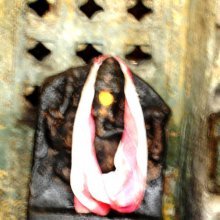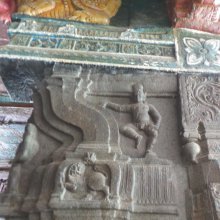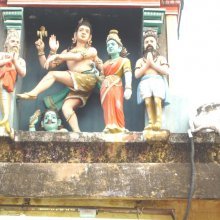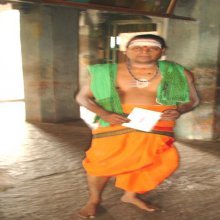Nartana, Narttana: 14 definitions
Introduction:
Nartana means something in Hinduism, Sanskrit, Marathi, Hindi. If you want to know the exact meaning, history, etymology or English translation of this term then check out the descriptions on this page. Add your comment or reference to a book if you want to contribute to this summary article.
Alternative spellings of this word include Nartan.
Images (photo gallery)
In Hinduism
Purana and Itihasa (epic history)
Source: archive.org: Shiva Purana - English TranslationNartana (नर्तन) refers to “dance”, according to the Śivapurāṇa 2.3.53 (“Description of Śiva’s return journey”).—Accordingly, as Brahmā narrated to Nārada: “[...] Then the ladies of the city indulged in the customary utterance of foul abusive words laughing, jingling and peeping at all of them. [...] On the fourth day, the rite of caturthīkarman was performed with due observance. Without this the marriage rites would have been incomplete. There was diverse jubilant festivity. Shouts of ‘well-done’, ‘victory’ etc were heard. There were exchanges of gifts, sweet music and different kinds of dances (nartana) [narttanamvividhantathā]. [...]”

The Purana (पुराण, purāṇas) refers to Sanskrit literature preserving ancient India’s vast cultural history, including historical legends, religious ceremonies, various arts and sciences. The eighteen mahapuranas total over 400,000 shlokas (metrical couplets) and date to at least several centuries BCE.
Languages of India and abroad
Marathi-English dictionary
Source: DDSA: The Molesworth Marathi and English DictionaryNarttana (नर्त्तन).—n S Dancing, gesticulating, acting, playing.
Source: DDSA: The Aryabhusan school dictionary, Marathi-Englishnartana (नर्तन).—n Dancing.
Marathi is an Indo-European language having over 70 million native speakers people in (predominantly) Maharashtra India. Marathi, like many other Indo-Aryan languages, evolved from early forms of Prakrit, which itself is a subset of Sanskrit, one of the most ancient languages of the world.
Sanskrit dictionary
Source: DDSA: The practical Sanskrit-English dictionaryNartana (नर्तन).—[nṛt-lyuṭ] A dancer; Mahābhārata (Bombay) 12 63.4.
-nam Gesticulation, dancing, dance.
Derivable forms: nartanaḥ (नर्तनः).
Source: Cologne Digital Sanskrit Dictionaries: Shabda-Sagara Sanskrit-English DictionaryNarttana (नर्त्तन).—n.
(-naṃ) Dancing, gesticulating, acting. E. nṛt to dance, &c. affix bhāve lyuṭ .
Source: Cologne Digital Sanskrit Dictionaries: Benfey Sanskrit-English DictionaryNartana (नर्तन).—i. e. nṛt + ana. I. m. A dancer, Mahābhārata 4, 1217. Ii. n. Dancing, [Mānavadharmaśāstra] 2, 178.
Source: Cologne Digital Sanskrit Dictionaries: Cappeller Sanskrit-English DictionaryNartana (नर्तन).—[masculine] dancer; ([feminine] ā &) [neuter] dance.
Source: Cologne Digital Sanskrit Dictionaries: Monier-Williams Sanskrit-English Dictionary1) Nartana (नर्तन):—[from narta] m. (initial n not changeable to ṇ [gana] kṣubhnādi) dancer, [Mahābhārata; Harivaṃśa]
2) [v.s. ...] n. dancing, acting (metric. also f(ā). ; cf. nā-gṛha, below).
Source: Cologne Digital Sanskrit Dictionaries: Yates Sanskrit-English DictionaryNarttana (नर्त्तन):—(naṃ) 1. n. Dancing, acting.
Source: DDSA: Paia-sadda-mahannavo; a comprehensive Prakrit Hindi dictionary (S)Nartana (नर्तन) in the Sanskrit language is related to the Prakrit words: Ṇaccaṇa, Ṇattaṇa.
[Sanskrit to German]
Sanskrit, also spelled संस्कृतम् (saṃskṛtam), is an ancient language of India commonly seen as the grandmother of the Indo-European language family (even English!). Closely allied with Prakrit and Pali, Sanskrit is more exhaustive in both grammar and terms and has the most extensive collection of literature in the world, greatly surpassing its sister-languages Greek and Latin.
Hindi dictionary
Source: DDSA: A practical Hindi-English dictionaryNartana (नर्तन) [Also spelled nartan]:—(nm) dancing, dance; ~[rtita] dancing; danced.
...
Kannada-English dictionary
Source: Alar: Kannada-English corpusNartana (ನರ್ತನ):—
1) [noun] the art of dance.
2) [noun] a performance of dance; a dancing.
Kannada is a Dravidian language (as opposed to the Indo-European language family) mainly spoken in the southwestern region of India.
See also (Relevant definitions)
Starts with: Nartana-vinayaka, Nartanabhru, Nartanabindu, Nartanagara, Nartanagarti, Nartanagati, Nartanagriha, Nartananirnaya, Nartanapriya, Nartanashala, Nartanashale, Nartanasthana, Nartanavidye.
Ends with: Anartana, Caturanartana, Hastanartana, Kekinartana, Padanartana, Parinartana, Pranartana, Sahanartana, Samgitanartana.
Full-text (+11): Nartanashala, Narttanapriya, Sahanarttana, Nartanapriya, Nartanagriha, Nartananirnaya, Sangita, Nartanasthana, Parinartana, Nattanam, Nartanagara, Naccana, Sahanritya, Nattana, Nartan, Sahanartana, Natana, Nirttanam, Anartana, Manavarjita.
Relevant text
Search found 15 books and stories containing Nartana, Narttana; (plurals include: Nartanas, Narttanas). You can also click to the full overview containing English textual excerpts. Below are direct links for the most relevant articles:
Brihad Bhagavatamrita (commentary) (by Śrī Śrīmad Bhaktivedānta Nārāyana Gosvāmī Mahārāja)
Verse 2.4.69 < [Chapter 4 - Vaikuṇṭha (the spiritual world)]
Verse 1.5.1 < [Chapter 5 - Priya (the beloved devotees)]
Gati in Theory and Practice (by Dr. Sujatha Mohan)
Technical treatises on Nāṭya (other works) < [Chapter 1 - Nāṭya]
Analysis of technical terms: Nāṭya, Nṛtta, Nṛtya < [Chapter 1 - Nāṭya]
Gati, as found in classical theatres of Kūḍiāṭṭam < [Chapter 4 - Practice of Gati]
Bhakti-rasamrta-sindhu (by Śrīla Rūpa Gosvāmī)
Verse 3.2.65 < [Part 2 - Affection and Service (dāsya-rasa)]
Manusmriti with the Commentary of Medhatithi (by Ganganatha Jha)
Verse 2.178 < [Section XXX - Rules to be observed by the Religious Student]
The Coming of Ashadha < [May-June, 1929]
The Aesthetics of Indian Dance < [January – March, 1985]
Reviews < [October - December 1972]
Bhajana-Rahasya (by Srila Bhaktivinoda Thakura Mahasaya)
Text 18 < [Chapter 8 - Aṣṭama-yāma-sādhana (Rātri-līlā–prema-bhajana sambhoga)]



